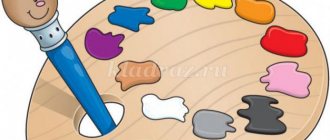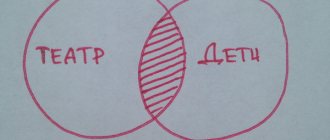Thematic planning of circle work on theatrical activities
Natalya Trofimovich
Thematic planning of circle work on theatrical activities
Thematic planning of circle work on theatrical activities for 2018-2022.
Theatrical activities are implemented by staging fairy-tale performances based on author's fairy tales and works of art in accordance with the cyclogram of holidays held in the Children's Home.
Explanatory note.
In our world, saturated with information and stress, the soul asks for a fairy tale - a miracle, a feeling of carefree childhood.
In the soul of every child lies a desire for free theatrical play , in which he reproduces familiar literary plots. This is what activates his thinking, trains memory and visual perception, develops imagination and fantasy, and improves speech. And to overestimate the role of the native language, which helps people, especially children, to consciously perceive around them and is a means of communication. S. Ya. Rubinstein wrote: “The more expressive the speech, the more the speaker, his face, himself appears in it.” Such speech includes verbal (intonation, vocabulary and syntax)
and non-verbal
(facial expressions, gestures, posture)
means.
To develop the expressive side of speech, it is necessary to create conditions in which each child could express his emotions, feelings, desires and views, not only in ordinary conversation, but also publicly.
The habit of expressive public speech can be cultivated in a person only by involving him in speaking in front of an audience from an early age. Theatrical games can be of great help with this . They always make children happy and are always loved by them.
Theatrical activities allow the child:
• to develop the experience of social behavior skills, since every literary work or fairy tale for children always has a moral orientation (friendship, kindness, honesty, courage, etc.)
. Thanks to a fairy tale, a child learns about the world not only with his mind, but also with his heart. And he not only knows, but also expresses his own attitude towards good and evil.
• solve many problematic situations indirectly on behalf of a character. This helps overcome timidity, self-doubt, and shyness.
The above determined the approach to drawing up the program the Dramatushki theatrical club
.
Goal: development of children's creative abilities through theatrical art .
Objectives: to create conditions for the development of creative activity of children studying in a theater club , as well as the gradual development by children of various types of creativity
— teach children manipulation techniques in puppet theaters of various types ;
- improve children’s artistic skills in terms of experiencing and embodying the image, as well as their performing skills;
— familiarize children with various types of theaters : widely use different types of theater in children’s theatrical activities ;
— introduce children to theatrical culture , enrich their theatrical experience .
- guide children to create the necessary attributes and decorations for the future performance;
- take initiative in distributing responsibilities and roles among themselves;
- develop creative independence, aesthetic taste in conveying an image, and clarity of pronunciation;
— learn to use means of artistic expression (intonation-colored speech, expressive movements, musical accompaniment corresponding to the figurative structure of the performance, lighting, scenery, costumes);
- cultivate a love for the theater ;
— to educate a harmoniously developed personality in the process of co-creation and cooperation.
SEPTEMBER.
1-2 weeks.
-Acquaintance with the theater , theatrical professions (artist, make-up artist, decorator, costume designer, actor)
.
“We are playing
theater ” - articulation gymnastics.
“We are future artists”
is an exercise to develop expressive plasticity of movements, to develop expressive facial expressions.
3 – 4 weeks.
—“I’ll change myself, friends, guess who I am?”
- dressing up in costumes, imitation sketches.
– Theatrical sketch “The Turnip Game”
- reading - conversation on the content, searching for expressive intonations, facial expressions, gestures to convey the image.
OCTOBER.
1 – 2 weeks.
— Acquaintance with types of theaters (shadow, tabletop)
in the first junior group. Goal: to introduce children to different types
of theaters ; deepen interest in theatrical games ;
enrich your vocabulary. 3 – 4 weeks.
— Continued acquaintance with types of theaters (tabletop, finger theater, bibabo puppet theater )
.Goal: to continue to introduce types of
theaters , enriching the vocabulary.
— Fairy tale “Masha and the Bear”
-
work on individual episodes, expressiveness of speech.
— Adults show children fairy tales with scenery details, musical accompaniment, and costume elements. NOVEMBER.
1 – 2 weeks.
— Acquaintance with the finger theater . Purpose: to develop interest in various theatrical activities ; continue to introduce children to the finger theater . – Mastering the skills of mastering this type of theatrical activity . Goal: to continue to introduce the skills of mastering finger theatrical activities , to develop fine motor skills of the hands in combination with speech.
3 – 4 weeks.
— Decorating the scenery for the Russian folk tale “Teremok”
(adults)
.
— With the guys from the “Little Fox”
, look at the illustrations for the fairy tale
“Teremok”
, discuss the content of the fairy tale, try to involve the children in improvisation.
– Work on individual episodes, expressive speech.
— Dramatization of the Russian folk tale “Teremok”
- music room.
DECEMBER.
1 – 2 weeks.
— Introduction to the concept of “role-playing dialogue”
.Goal: to develop the ability to build dialogues between characters in imaginary circumstances; develop coherent speech; expand the figurative structure of speech; cultivate patience and endurance.
3 - 4 weeks. – Reading the Russian folk tale “The Wolf and the Little Goats”
.Goal: to develop attention, perseverance, stimulate children’s emotional perception of fairy tales; cultivate a friendly attitude between children.
— Puppet theater , on flannelgraph in the group “Kitten”
fairy tales
"The Wolf and the Little Goats"
. Have a conversation based on a fairy tale.
— Involve children in the tradition of celebrating the New Year.
JANUARY.
1 – 2 weeks. – Introduction to shadow theater . Goal: to continue to introduce children to different types of theaters ; evoke a joyful emotional mood in children; develop creative abilities. – Showing adults the Russian folk tale “Zayushkina’s Hut”
(shadow
theater ) . Purpose: to create a positive emotional mood;
stimulate interest in theatrical activities .
3 -4 weeks. – Introduction to the type of theatrical activity (soft toy)
.Goal: to continue to introduce the type of
theatrical activity (soft toy)
. Develop hand motor skills in combination with speech.
FEBRUARY.
1 – 2 weeks.
— Introducing tabletop theater . Goal: to continue introducing children to tabletop theater . – Mastering tabletop theater .
3 – 4 weeks. - “Guess by the sound”
develop the auditory attention of children from the
“Little Fox”
.
– Learning the rhythmic round dance game “Dwarfs and Giants.”
Goal: to develop the ability to convey basic emotions through facial expressions, gestures, and movements.
MARCH.
1 – 2 weeks.
— Acquaintance with the type of theatrical activity - mask theater . Goal: to continue to introduce children to the mask theater ; develop creative interest.
APRIL.
1 – 2 weeks.
- Introduction to the introduction of theatrical activities - puppets - Parsley. – Children’s mastering the skills of controlling dolls – Parsleys. Goal: to teach children to control dolls – Parsleys; cultivate interest in a new type of theater .
3 – 4 weeks.
— Dramatization of the Russian folk tale “Ryaba Hen”
Goal: to create a joyful mood in children; learn to imitate the voices of heroes.
MAY.
1 – 2 weeks.
— Fairy tale “Turnip in a new way”
. Introduction to the characters of the fairy tale, distribution of roles. Distribute, learn roles in groups. Purpose: to develop imagination, fantasy, memory in children; ability to communicate in the given circumstances; experience the joy of communication.
3 -4 weeks.
-Test performance based on the fairy tale “Turnip in a new way”
.Goal: to develop a sense of rhythm and coordination of movements in movements;
expand the range due to the sound of the voice. – Performance of a performance based on the fairy tale “Turnip in a new way.”
Purpose: to create a positive emotional mood;
develop a sense of self-confidence; introduce children to the art of theater .




